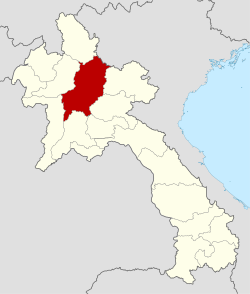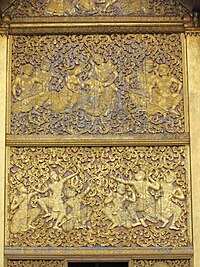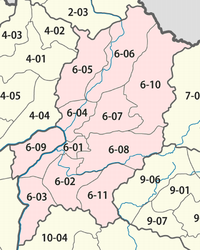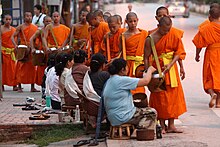Luang Prabang Province
Luang Prabang Province .mw-parser-output .noboldfont-weight:normal ແຂວງ ຫລວງພະບາງ | |
|---|---|
Province | |
 | |
 Map of Luang Prabang Province | |
 Location of Luang Prabang Province in Laos | |
| Coordinates: 20°13′N 102°37′E / 20.21°N 102.62°E / 20.21; 102.62Coordinates: 20°13′N 102°37′E / 20.21°N 102.62°E / 20.21; 102.62 | |
| Country | |
| Capital | Luang Prabang |
| Area | |
| • Total | 16,875 km2 (6,515 sq mi) |
| Population (2015 census) | |
| • Total | 431,889 |
| • Density | 26/km2 (66/sq mi) |
| Time zone | UTC+07 |
| ISO 3166 code | LA-LP |
HDI (2017) | medium · 11th |
| UNESCO World Heritage Site | |
| Official name | Town of Luang Prabang |
| Criteria | Cultural: (ii)(iv)(v) |
| Reference | 479bis |
| Inscription | 1995 (19th Session) |
| Extensions | 2013 |
| Area | 820 ha (2,000 acres) |
| Buffer zone | 12,560 ha (31,000 acres) |
Luang Prabang (also Louangphabang, Lao ຫລວງພະບາງ) is a province of Laos, located in the north of the country. Its capital of the same name, Luang Prabang, was the capital of Lane Xang Kingdom during the 13th to 16th centuries. It is listed since 1995 by UNESCO as a World Heritage Site for unique architectural, religious and cultural heritage, a blend of the rural and urban developments over several centuries, including the French colonial influences during the 19th and 20th centuries. The province has 12 districts, Luang Prabang, Xieng Ngeun, Nan, Pak Ou, Nambak, Ngoi, Pakseng, Phonxay, Chomphet, Viengkham and Phoukhouny. The Royal Palace, the national museum in the capital city, and the Phou Loei Protected Reserve are important sites. Notable temples in the province are the Wat Xieng Thong, Wat Wisunarat, Wat Sen, Wat Xieng Muan, and Wat Manorom. The Lao New Year is celebrated in April as The Bun Pi Mai.
Contents
1 History
2 Geography
3 Protected areas
4 Administrative divisions
5 Demographics
6 Economy
7 Landmarks
8 Culture
9 References
9.1 Bibliography
10 External links
History
Luang Prabang is the ancient capital of Lan Xang ("one million elephants") and is one of the oldest cities in Laos, founded approximately 1,200 years ago.[2] It was previously known by two other names, Muang Sawa (or Muang Sua) and Xieng Dong Xieng Thong.[3] It became the first capital of Laos in the 14th century when King Fa Ngum returned from Cambodia where he and his father were exiled by the previous king, Fa Ngum's grandfather. Fa Ngum had the support of the Khmer kingdom centered at Siem Reap and brought with him thousands of soldiers to assist in establishing his own kingdom. Luang Prabang was known as Muang Sua around the 11th century,[3] but the settlement's name was changed after Cambodia gave a gold image of the Buddha, the Phra Bang, as a gift. The Phra Bang became the symbol of the city,[2] and the Buddha image is on display at the museum. Nan-chao occupied Muang Sua in 709 and its princes or administrators replaced the Tai aristocracy.[2] The occupation probably ended before the Khmer empire's northward expansion under Indravarman I (r. 877-89).[2]
The Khmers founded an outpost at Xay Fong near Vientiane. The Champa expansion occurred in southern Laos through 1070. Chanthaphanit, the ruler of Xay Fong, invaded Muang Sua and was accepted as ruler with the departure of the Nan-chao administrators. Though Chanthaphanit and his son had long reigns, the dynasty had troubles with several principalities, leading to Khun Chuang, who may have been a Kammu tribesman, extending his territory to Muang Sua and ruling from 1128 to 1170.[2] The family of Khun Chuang reinstituted the Siamese administrative system of the 7th century. The territory experienced a brief period of Khmer suzerainty under Jayavarman VII from 1185 to 1191.[4] After the town became the center of a localized kingdom in the 13th century, it became known by the Tai name Xieng Dong Xieng Thong,[3] which in 1353 became the capital of Lan Xang. The capital was moved in 1560 by King Setthathirath I to Vientiane, at which time, Xieng Dong Xieng Thong was renamed Luang Prabang, meaning "City of the Lord (Buddha) of Fine Gold", in recognition of the Phra Bang gift received centuries earlier.[3]
After Lan Xang had troubles in 1707, Luang Prabang became the capital of the independent Luang Prabang kingdom. When France annexed Laos, the French recognised Luang Prabang as the royal residence of Laos. Eventually, the ruler of Luang Prabang became synonymous with the figurehead of the French Protectorate of Laos. When Laos achieved independence, the king of Luang Prabang, Sisavang Vong, became the head of state for the Kingdom of Laos. In 1941, following the Franco-Thai War, Thailand occupied part of the province, which was named Lan Chang Province. On March 9, 1945, independence was declared for Laos, and Luang Prabang was the capital. Colonel Hans Imfeld, commissioner of the French Republic, entered Luang Prabang on 25 August 1945 with a party of Franco-Laotian guerrillas and received assurances from the King that the protectorate was still in force.[5]
After the Washington Accord of 1946, the Thai government ceded the annexed territories of Luang Prabang and Xaignabouli provinces back to Laos.[6]
Geography
Luang Prabang Province one of the provinces of Laos,[7] covers an area of 16,875 square kilometres (6,515 sq mi).[8] The province borders Phongsali Province to the north, Vietnam to the northeast, Houaphan Province to the east, Xiangkhouang Province to the southeast, Vientiane Province to the south, Xaignabouli Province to the southwest, and Oudomxay Province to the west.[9] The provincial capital and old seat of the kingdom, Luang Prabang city, can be accessed via Bangkok Airways, Lao Airlines, or Vietnam Airlines who all service Luang Prabang International Airport.[10] The capital is situated on a narrow peninsula that bisects the conjunction of the Mekong River, flowing south along the west side of the city, and the Nam Khan, a tributary of the Mekong that flows from the east but angles north just before the confluence of the two rivers. The tip of the peninsula is the site of a wat that was frequented by the royal family when it resided there, and is still a site of devotion for local Lao Buddhists as well as increasingly frequent tourists.[11][12] In the center of the peninsula is a Mount, Phousi, which despite the constrained scale of the city, is 150 metres (490 ft) high; a steep stair leads to a shrine and an overlook of the city and the rivers.[13][14]
Protected areas
The 60,070 hectare Phou Louey Massif Important Bird Area (IBA) is within the Nam Et-Phou Louey National Biodiversity Conservation Area (NBCA). The IBA is also within the provinces of Luang Prabang and Houaphanh. It is situated at an altitude of 700–1,800 metres (2,300–5,900 ft) above sea level. The habitat contains mixed deciduous forest, semi-evergreen forest, lower montane evergreen forest, upper montane evergreen forest, and secondary grassland. Notable avifauna include beautiful nuthatch Sitta formosa, Blyth's kingfisher Alcedo hercules, rufous-necked hornbill Aceros nipalensis, and yellow-vented warbler Phylloscopus cantator.[15]
The Phou Loei Protected Reserve (PLI) encompassing an area of 1,465 square kilometres (566 sq mi), lies in Luang Prabang and Houapahn provinces. It was established in 1993. Its topography is made up of rugged highlands with elevation ranging between 500–2,257 metres (1,640–7,405 ft) and is drained by the Nam Khan and Nam Xuang Rivers, which flow primarily in southwest direction. Land distribution consists of 87% forest. The forest is of mixed deciduous and evergreen type with abundance of bamboo and grasslands resulting from shifting cultivation. Faunal species reported from the reserve are mainly clouded leopard, tiger, and
leopard, and large cats which are endemic to Indochina. Route 7 and Route 1 are the roads leading to the reserve; the former from Phonsavanh and the latter from Meuang Hiam, while its northern area has a seasonal road; access is also available from Luang Prabang.[16][17]
Administrative divisions
@media all and (max-width:720px).mw-parser-output .tmulti>.thumbinnerwidth:100%!important;max-width:none!important.mw-parser-output .tmulti .tsinglefloat:none!important;max-width:none!important;width:100%!important;text-align:center


The province is made up of the following 12 districts:[8]
| Map | Code | Name | Lao |
|---|---|---|---|
 | |||
| 6-01 | Louangphrabang District | ເມືອງຫຼວງພະບາງ | |
| 6-02 | Xiengngeun District | ເມືອງຊຽງເງິນ | |
| 6-03 | Nane District | ເມືອງນານ | |
| 6-04 | Pak Ou District | ເມືອງປາກອູ | |
| 6-05 | Nam Bak District | ເມືອງນ້ຳບາກ | |
| 6-06 | Ngoy District | ເມືອງງອຍ | |
| 6-07 | Pak Seng District | ເມືອງປາກແຊງ | |
| 6-08 | Phonxay District | ເມືອງໂພນໄຊ | |
| 6-09 | Chomphet District | ເມືອງຈອມເພັດ | |
| 6-10 | Viengkham District | ເມືອງວຽງຄຳ | |
| 6-11 | Phoukhoune District | ເມືອງພູຄູນ | |
| 6-12 | Phonthong District | ເມືອງໂພນທອງ |
Demographics
The population of the province as of March 2005 census is 407,012.[18]
Economy
The self-financed OckPopTok weaving centre and textile gallery is based in Luang Prabang. It designs and produces textiles and handicrafts. It was established as a partner of the Lao Women's Union and other rural communities of artisans. OckPopTok provides jobs for almost 200 people.[19]
Landmarks

Luang Prabang

Haw Kham Royal Palace
The capital city of Luang Prabang is the most notable landmark of the province and became a World Heritage Site in 1995.[11][12] According to a legend, Buddha visited this place and predicted that it would become a rich and prosperous city. It was in the following centuries that it became the capital of the Kingdom of Lan Xang, and the centre of Buddhism. The city developed with royal administrative complexes amidst temples and monasteries.[11][12]
The National Museum, built in 1904, has exhibits of royal religious artifacts in the entrance hall, as well as a rock from the moon. Of particular importance is the 14th century gold Phra Bang which has rendered its name to the province.[8]
- Temples
There are several landmark temples in the provincial capital city. Wat Wisunarat has a watermelon-shaped stupa, while Wat Xieng Muan has a Buddhist art school.[20] Wat Manorom, the 6 metres (20 ft) tall, bronze, sitting Buddha, built in 1382, was badly damaged in 1887, but was renovated in 1919 and in 1971. Wat That Luang, originally established in the 3rd century BC by Ashokan missionaries, is the traditional cremation place for Lao royalty. Steps from Wat Phabaht lead to a large, holy footprint. Wat Xieng Maen, founded in 1592, housed the Pha Bang for seven nights after decades in Thai hands. Wat Chomphet, established in 1888, is accessed via a stairway of 123 steps, and contains two pagodas. Wat Manorom contains a 6 metres (20 ft) tall, bronze, sitting Buddha.[21]
Wat Xieng Thong temple, in typical Laotian architecture, was built in the 16th century (1559–1560) during the reign of King Saysetthathirath, at the confluence of the Mekong and Nam Khan rivers. Its notability within the country and in Asia is credited to its Buddhist art and architecture. An artifact of funerary nature kept in the temple complex is a richly carved and gilded funeral vehicle of the former king, and also the remains of King Sisavangvon. Royal ceremonies were held here until 1975.[8][22] The wat has carved gilded, wooden doors which depict scenes from Buddha's life. The ceiling in the sim displays Dharmachakras, dharma wheels symbolising Buddhist law and the circle of reincarnation. The outer walls of the sim depict Lao legends, and the rear gable is decorated with a glass mosaic depicting the tree of life. The outer walls of the Sanctuary of the Reclining Buddha, also known as the Red Chapel, are decorated with mosaics.[22]
Culture

The monks' alms procession at dawn includes receiving sticky rice.
The Bun Pi Mai festival occurs in April to celebrate the Lao New Year. The celebration includes Tak Bat, monks' alms procession, which passes by the Wat Ho Siang.[23] The Royal Lao Ballet performs at the Phrolak-Phralam Theatre on the Royal Palace Grounds in the provincial capital.[10]
References
| Wikimedia Commons has media related to Luang Prabang Province. |
^ "Sub-national HDI - Area Database - Global Data Lab". hdi.globaldatalab.org. Retrieved 2018-09-13..mw-parser-output cite.citationfont-style:inherit.mw-parser-output qquotes:"""""""'""'".mw-parser-output code.cs1-codecolor:inherit;background:inherit;border:inherit;padding:inherit.mw-parser-output .cs1-lock-free abackground:url("//upload.wikimedia.org/wikipedia/commons/thumb/6/65/Lock-green.svg/9px-Lock-green.svg.png")no-repeat;background-position:right .1em center.mw-parser-output .cs1-lock-limited a,.mw-parser-output .cs1-lock-registration abackground:url("//upload.wikimedia.org/wikipedia/commons/thumb/d/d6/Lock-gray-alt-2.svg/9px-Lock-gray-alt-2.svg.png")no-repeat;background-position:right .1em center.mw-parser-output .cs1-lock-subscription abackground:url("//upload.wikimedia.org/wikipedia/commons/thumb/a/aa/Lock-red-alt-2.svg/9px-Lock-red-alt-2.svg.png")no-repeat;background-position:right .1em center.mw-parser-output .cs1-subscription,.mw-parser-output .cs1-registrationcolor:#555.mw-parser-output .cs1-subscription span,.mw-parser-output .cs1-registration spanborder-bottom:1px dotted;cursor:help.mw-parser-output .cs1-hidden-errordisplay:none;font-size:100%.mw-parser-output .cs1-visible-errorfont-size:100%.mw-parser-output .cs1-subscription,.mw-parser-output .cs1-registration,.mw-parser-output .cs1-formatfont-size:95%.mw-parser-output .cs1-kern-left,.mw-parser-output .cs1-kern-wl-leftpadding-left:0.2em.mw-parser-output .cs1-kern-right,.mw-parser-output .cs1-kern-wl-rightpadding-right:0.2em
^ abcde Savada 1995, p. 7.
^ abcd Ring & Watson 2012, p. 530.
^ Ray 2009, p. 33.
^ Savada, Andrea Matles (editor) (1994) "Events in 1945" A Country Study: Laos Federal Research Division, Library of Congress
^ Paul Lévy, Histoire du Laos, PUF, 1974, p.89-90
^ "Home". Regions. Official website of Laos Tourism. Retrieved 7 January 2013.
^ abcd "Luang Prabang Province, the world Heritage City". Lao Tourism Organization. Retrieved 1 December 2012.
^ Maps (Map). Google Maps.
^ ab Bush & Elliot 2010, pp. 167.
^ abc "Town of Luang Prabang". UNESCO. Retrieved 8 December 2012.
^ abc "World Hewritrage List Luang Prabang N0735: Evaluation" (pdf). UNESCO.org. Retrieved 8 December 2012.
^ Cavendish 2007, p. 809.
^ Daniel White (28 January 2010). Frommer's Cambodia and Laos. John Wiley & Sons. pp. 270–. ISBN 978-0-470-61583-6. Retrieved 3 January 2013.
^ "Important Bird Areas factsheet: Phou Louey". BirdLife International. Retrieved 6 December 2012.|first1=missing|last1=in Authors list (help)
^ "Phou Loei". Official Website of Ecotourism Organization. Archived from the original on 7 June 2013. Retrieved 8 December 2012.
^ "Phou Loei (PLI; 4)". Official web site of Eco Tourism Organization. Archived from the original on 22 November 2010. Retrieved 8 December 2012.
^ "Provinces of Laos". Statoids.com. Retrieved 8 November 2012.
^ "Luang Prabang Shopping". The New York Times. Retrieved 8 December 2012.
^ Burke & Vaisutis 2007, p. 25.
^ Bush & Elliot 2010, p. 156.
^ ab Cavendish 2007, p. 798-799.
^ Bush & Elliot 2010, pp. 155, 159.
Bibliography
Burke, Andrew; Vaisutis, Justine (1 August 2007). Laos 6th Edition. Lonely Planet. pp. 25–. ISBN 978-1-74104-568-0.
Bush, Austin; Elliot, Mark; Ray, Nick (1 December 2010). Laos 7. Lonely Planet. pp. 156–. ISBN 978-1-74179-153-2.
Cavendish, Marshall (September 2007). World and Its Peoples: Eastern and Southern Asia. Marshall Cavendish Corporation. pp. 798–799. ISBN 978-0-7614-7639-9.
Ray, Nick (11 September 2009). Lonely Planet Vietnam Cambodia Laos & the Greater Mekong. Lonely Planet. pp. 33–. ISBN 978-1-74179-174-7.
Ring, Trudy; Watson, Noelle; Schellinger, Paul (12 November 2012). Asia and Oceania: International Dictionary of Historic Places. Taylor & Francis. pp. 530–. ISBN 978-1-884964-04-6.
Savada, Andrea Matles (1995). Laos: a country study. Federal Research Division, Library of Congress. pp. 7–. ISBN 978-0-8444-0832-3.
External links
- Official website
